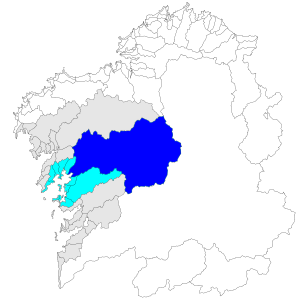Ulla (river) facts for kids
Quick facts for kids Ulla River |
|
|---|---|

River Ulla
|
|

Ulla river basin (dark blue)
|
|
| Country | Spain |
| State | Galicia (Spain) |
| Physical characteristics | |
| Main source | Montes da Vacaloura, Monterroso, Province of Lugo |
| Length | 132 km (82 mi) |
| Basin features | |
| Basin size | 2,803 km2 (1,082 sq mi) |
| Tributaries |
|
The Ulla (río Ulla in Galician and Spanish) is a river in Galicia, Spain.
Its source is sometimes given as Antas de Ulla and sometimes the neighbouring municipality of Monterroso. It flows to Ría de Arosa. Its basin is the largest in Galicia after the Minho River. Tributaries include the rivers Deza and Arnego.
The river is also valued by archaeologists owing to the large number of artifacts, dating as far back as the Neolithic, discovered here. The outlet of the Ulla River and the mouth of the estuary, called Ría de Arousa, are the two sites where archaeologists have discovered remains consistently. Rock carvings have been discovered here. The Ulla River is also important because it is the river in the northwest of the Iberian Peninsula to produce a large number of watery hoards, which were discovered in its lower reaches and its mouth.
Etymology
According to E. Bascuas, "Ulla" is a form belonging to the old European hydronymy, and derived from the Indoeuropean root *wel- 'wheel, rotate'. This toponym is registered in 906 as "(fluvius) Volia", which had derived from a previous form *Wulia.
See also
 In Spanish: Río Ulla para niños
In Spanish: Río Ulla para niños
- List of rivers of Spain
- Rivers of Galicia

